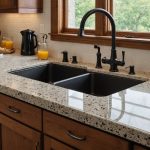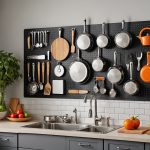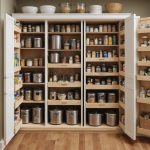Understanding Kitchen Ventilation Systems
Kitchen ventilation is vital for maintaining good air quality and reducing odors in your home. When cooking, fumes, smoke, and smells can accumulate, impacting both your health and comfort. Effective kitchen ventilation ensures these byproducts are efficiently extracted.
Types of Kitchen Ventilation Systems
There are several types of systems that can be used to enhance air quality in kitchens. The most common are range hoods and extractors. Range hoods, mounted above the stove, utilise a fan to remove airborne contaminants. Some feature filters to trap grease before venting outside. Extractor fans, on the other hand, are generally installed on walls or ceilings, venting internal air directly outdoors, making them ideal for smaller kitchens without hoods.
Also read : Ultimate guide to choosing the ideal refrigerator size for your expanding family in the uk
Importance of Kitchen Ventilation for Air Quality
Ensuring you have a proper system in place is crucial for odour management. Consistently ventilated air reduces lingering smells and prevents moisture build-up, which can lead to mould growth and impact long-term air quality.
Factors Influencing Choice
When selecting a kitchen ventilation system in UK homes, consider the kitchen size, layout, and cooking habits. Local building regulations may also dictate installation specifics, ensuring the ventilation system is compliant and effective in maintaining household air quality.
Topic to read : Creative pantry organization tips: space-savvy solutions for slim kitchens in the uk
Installing Kitchen Ventilation Systems
For those looking to improve their kitchen environment, understanding the installation guide for ventilation systems is key. We’ll walk you through the step-by-step process to ensure a successful setup.
Tools Required for Installation
To start, you’ll need a range of essential tools and materials. These include a drill, screwdriver, measuring tape, and level. Additionally, gather the appropriate fittings and seals specified in the instructions for your particular system. Having these items at hand will facilitate a smoother installation experience, allowing you to focus on precision and efficiency.
Preparing the Installation Area
Prior to starting the installation, thorough preparation of the area is crucial. Begin by clearing the space, ensuring it’s free of obstructions. Measure the dimensions of your kitchen to confirm that the ventilation system fits perfectly. Safety precautions should always be followed, such as wearing protective gear and ensuring proper ventilation during the process. These measures help to prevent accidents and ensure your safety and the longevity of the installation.
Mounting the Ventilation System
Once the area is ready, you can proceed with mounting the ventilation system. This involves securely attaching the unit to the designated spot, using the correct screws and fixings. Make sure the system is level and fully supported before connecting it to power. Properly securing and connecting your ventilation system is vital for optimal performance. By adhering to these steps and tips, you can ensure a safer and more efficient kitchen environment.
Local Building Regulations and Codes
Understanding the nuances of UK building regulations for kitchen ventilation is crucial for ensuring both compliance and safety. These regulations are designed to safeguard the health and well-being of residents by controlling the removal of cooking fumes, moisture, and other pollutants. UK building regulations specify key aspects such as the rate of ventilation required, duct specifications, and exhaust outlet placements. This ensures that kitchens are adequately ventilated, lowering risks of hazards like smoke damage or harmful residue build-up.
Complying with these regulations is not just a legal requirement but a vital aspect of promoting a safe and livable environment. Inadequate ventilation can lead to health issues due to poor air quality and result in structural damage over time because of excess condensation. Furthermore, compliance with these safety standards protects against potential legal liabilities and hefty fines that can arise from non-compliance.
Neglecting local building codes can have serious consequences. Besides immediate safety hazards, it can lead to complications in selling or insuring your property. Buildings not meeting these standards may be required to undergo costly modifications to rectify any compliance issues. Therefore, it is advisable for homeowners and developers alike to ensure that all building projects adhere to relevant UK building regulations.
Choosing the Right Ventilation System
When selecting ventilation, it’s crucial to understand the key factors that will influence your decision. Firstly, consider the size and style of your space. A larger area may require a more robust system, whereas a smaller one might perform efficiently with a compact model. The design should complement the interior aesthetics while ensuring optimal air circulation.
Energy efficiency is another critical aspect that shouldn’t be overlooked. Opting for energy-efficient models can lead to significant savings on utility bills and contribute to environmental sustainability. Such models often have advanced features like variable speed settings that adjust the operation according to the air quality and occupancy in the room.
Noise levels are also essential to evaluate when choosing a system. Efficient systems should maintain low noise levels to ensure comfort, particularly in homes and offices where a quiet atmosphere is preferred. It is advisable to check the decibel ratings of different models.
Lastly, consider ease of maintenance. Systems that require minimal upkeep and have accessible parts for cleaning are ideal, as they ensure longevity and continuous high performance. By prioritising these factors, you can select a ventilation system that meets your needs effectively and enhances your living or working environment.
Maintenance and Care for Kitchen Ventilation Systems
Proper maintenance is vital for ensuring the longevity and optimal performance of kitchen ventilation systems. Routine upkeep can prevent expensive repairs and prolong the system’s life.
Regular Maintenance Actions
Regular attention is key for extending your ventilation system’s life. Here are some maintenance tips:
- Clean the filters monthly to prevent blockages.
- Inspect and wipe the fans to remove any grease buildup.
These actions not only maintain efficiency but also improve air quality in your kitchen.
When to Replace Parts
Recognising signs that parts need replacement is crucial. Look for:
- Unusual noises from the fan or motor.
- Reduced airflow or inefficiency in clearing smells.
Replacing worn-out parts promptly keeps the system running well. Consulting the manual or a professional for guidance can be beneficial.
Troubleshooting Common Issues
Frequent issues often arise due to improper installation. Some common problems include excessive noise and poor ventilation. Corrective measures involve:
- Tightening loose components to reduce noise.
- Ensuring the ducts are unblocked and correctly installed.
Addressing these problems early mitigates the risk of long-term damage. Effective troubleshooting requires awareness of potential issues, allowing for swift resolution and maintaining system effiency.
Adding Visual Aids for Enhanced Understanding
Utilising visual aids can significantly enhance one’s comprehension of complex tasks, such as installation processes. Visuals like diagrams and videos extend beyond written instructions by providing a more intuitive grasp of the steps involved. When tackling a particularly intricate installation, it’s beneficial to reference clear, detailed diagrams. These can often be found in product manuals or online resources dedicated to technical assistance.
For those needing additional guidance, video tutorials are incredibly helpful. They not only walk you through each step but also allow you to visualise tricky parts of the process. Websites like YouTube host countless channels devoted to such content, where experts share their insights and practical tips. Be sure to seek out videos from reputable creators to ensure the information is both accurate and reliable.
Incorporating both diagrams and installation videos into your learning strategy can transform a challenging task into a more manageable one. Whether you’re a visual learner or simply seeking to improve your understanding, these resources are indispensable, ensuring every step of your installation journey is clear and approachable. Diagrams and videos together can make a substantial difference in achieving a successful outcome.











